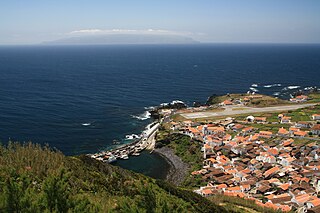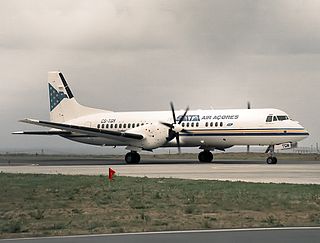SATA (Serial AT Attachment), a computer bus primarily used for connecting storage disks.
Contents
SATA or Sata may also refer to:
SATA (Serial AT Attachment), a computer bus primarily used for connecting storage disks.
SATA or Sata may also refer to:
Ural may refer to:
Santa Barbara or Santa Bárbara may refer to:

Azores Airlines, previously known as SATA Internacional, is a Portuguese airline based in the municipality of Ponta Delgada, on the island of São Miguel in the autonomous archipelago of the Azores. A subsidiary of SATA Air Açores, the airline operates as the international arm of the regional network, connecting the archipelago with Europe and North America, from its hub at João Paulo II Airport.

The British Aerospace ATP is an airliner designed and produced by British Aerospace. It was an evolution of the Hawker Siddeley HS 748, a fairly successful feederliner of the 1960s.
FLA may refer to:
Dao, Dão or DAO may refer to:

Air Transat Flight 236 was a transatlantic flight bound for Lisbon, Portugal, from Toronto, Canada, that lost all engine power while flying over the Atlantic Ocean on August 24, 2001. The Airbus A330 ran out of fuel because of a fuel leak caused by improper maintenance. Captain Robert Piché, 48, an experienced glider pilot, and First Officer Dirk DeJager, 28, glided the plane to a successful emergency landing in the Azores, saving all 306 people on board. Most of the passengers on the flight were Canadians visiting Europe or Portuguese expatriates returning to visit family in Portugal. This was also the longest passenger aircraft glide without engines, gliding for nearly 75 miles or 121 kilometres. Following this unusual aviation accident, this aircraft was nicknamed the "Azores Glider".
Jaws or Jaw may refer to:

SATA Air Açores is a Portuguese airline based in São Sebastião, Ponta Delgada in the Azores, Portugal. It operates scheduled passenger, cargo and mail services around the Azores. It provides its own maintenance and handling services and manages four regional airports. Its main base is at João Paulo II Airport, Ponta Delgada. It also maintains a subsidiary for mid- and long-haul flights, Azores Airlines, the former SATA International.

Ponta Delgada - João Paulo II Airport, named after Pope John Paul II, is an international airport located on the island of São Miguel, in the Portuguese archipelago of the Azores. Situated 2 km (1.2 mi) west of the city centre of Ponta Delgada, it is the primary airport in the Azores, as well as the fifth largest infrastructure managed by ANA Aeroportos de Portugal. The terminal was finished in 1995; by 2005 the airport served a total of 873,500 passengers. It has scheduled domestic flights to all islands of the Azores, plus Madeira and the mainland, namely. João Paulo II Airport also accommodates international flights to and from Europe and North America. The airport is the major hub for the SATA Group of airlines, which includes both inter-island SATA Air Açores and international Azores Airlines, and since April 2015 as a base for Ryanair.

Sata andagi are sweet deep fried buns of dough similar to doughnuts, native to Southern China, there named sa-yung, then spread to the Japanese prefecture of Okinawa. They are also popular in Hawaii, sometimes known there simply as andagi. Sata andagi is made by mixing flour, sugar and eggs. The ingredients are mixed into a ball and deep fried.

Santa Maria Airport is an international airport located 5 km (3.1 mi) west northwest of the urbanized area of Vila do Porto on the island of Santa Maria, in the Portuguese autonomous region of the Azores. A principal hub in transatlantic travel until the end of the 20th century, it was constructed at the start of the Second World War to protect convoys by American troops who were ceded authority until its end. From this period on, the airfield took on a commercial role, reinforced by inter-island travel and connections to Europe, resulting in its obtaining the communication duties for the North Atlantic sector of the airspace corridor.

Corvo Airport is an airport in the village of Vila do Corvo on the island of Corvo, in the Portuguese archipelago of the Azores. It is owned by the Regional Government of the Azores, but managed by SATA Air Açores.

Pico Airport is an airport located 8 km (5.0 mi) from Madalena on the Portuguese island of Pico in the archipelago of the Azores.

Ponta Delgada is the largest municipality (concelho) and economic capital of the Autonomous Region of the Azores in Portugal. It is located on São Miguel Island, the largest and most populous in the archipelago. As of 2021, it has 67,287 inhabitants, in an area of 232.99 square kilometres. There are 17,629 residents in the three central civil parishes that comprise the historical city: São Pedro, São Sebastião, and São José. Ponta Delgada became the region's administrative capital under the revised constitution of 1976; the judiciary and Catholic See remained in the historical capital of Angra do Heroísmo while the Legislative Assembly of the Azores was established in Horta.
SE, Se, or Sé may refer to:
Aviation in the Azores is part of the greater history of aviation in Portugal, and involves the historical use of the archipelago of the Azores by North American, South American and European pioneers of aviation. The Azores is strategically located in the centre of the North Atlantic Ocean between the continents of North America and Europe, and has played a historical role in trans-Atlantic navigation. The three primary airfields of the Azores are:

SATA Air Açores Flight 530M was a Portuguese regional commuter flight operated by SATA Air Açores, that connected Ponta Delgada-João Paulo II Airport and Flores Airport, with an intermediary stop at Horta, on 11 December 1999. At 10:20 a.m., the British Aerospace BAe ATP, named Graciosa, while enroute to Horta, collided with Pico da Esperança, on the central mountains of the island of São Jorge, resulting in the deaths of all 35 people on board. It is also the deadliest aviation accident involving the British Aerospace ATP.